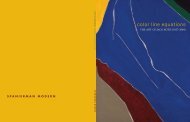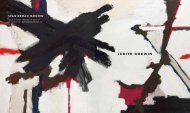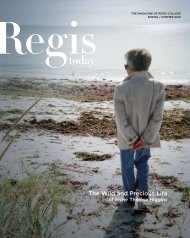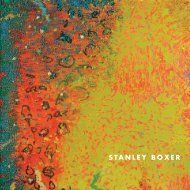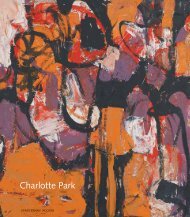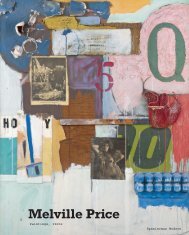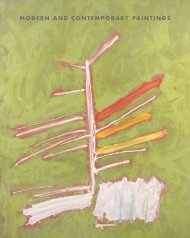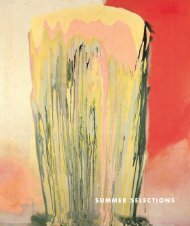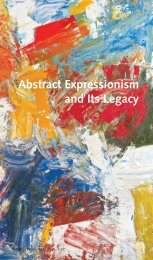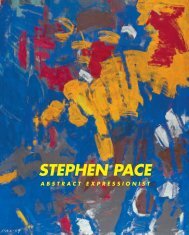Dan Christensen: The Stain Paintings - Spanierman Modern
Dan Christensen: The Stain Paintings - Spanierman Modern
Dan Christensen: The Stain Paintings - Spanierman Modern
Create successful ePaper yourself
Turn your PDF publications into a flip-book with our unique Google optimized e-Paper software.
It was works such as this to which the poet and<br />
critic John Ashbery referred in a review of an<br />
exhibition of <strong>Christensen</strong>’s art in 1979. In a day<br />
when artists had either taken the Minimal into the<br />
purely conceptual or had returned to representational<br />
forms of image-making, Ashbery found it<br />
“sobering and refreshing to turn to a number of<br />
artists who are extending the language of modernism<br />
in a more traditional and serious way.” He<br />
went on to note that “one younger artist who has<br />
renewed the tradition [of Color Field painting]<br />
honorably is <strong>Dan</strong> <strong>Christensen</strong>. His pale, vaporous<br />
washes of light are delectable. Often they are<br />
loosely organized along a white line which serves<br />
as an axis for vague blotches of color to relate to—<br />
sometimes like petals on a stem, or laundry on a<br />
clothesline, or clouds bisected by a telephone wire,<br />
though such comparisons are considered odious<br />
in discussions of this kind of work.” Ashbery<br />
found <strong>Christensen</strong>’s color occasionally “smoldering<br />
and sensuous,” but observed that the artist<br />
was “mainly interested in articulating the nuances<br />
separating patches of close-keyed dull pastel tones,<br />
and he does it masterfully. He forces the eye to<br />
recognize distinctions among areas of color which<br />
at Wrst have strong family resemblances and only<br />
somewhat later turn out to be mavericks who<br />
could just as easily be at odds with each other.”<br />
Referencing the universal metaphor of the Tree<br />
of Life, Ridge has an iconic quality, yet its freshness<br />
and simplicity make this work Wrst and foremost<br />
a sensuous optical experience, the product of an<br />
artist in love with the interaction of paint and<br />
surface and the inWnite ways of exploring their<br />
convergence.<br />
Lisa N. Peters<br />
1. Notable sources on <strong>Christensen</strong> include Sharon L.<br />
Kennedy, Douglas Drake, and Karen Wilkin, <strong>Dan</strong> <strong>Christensen</strong>:<br />
Forty Years of Painting, exh. cat. (Kansas City, Mo.: Kemper<br />
Museum of Contemporary Art, 2009); <strong>Dan</strong> <strong>Christensen</strong>: <strong>The</strong><br />
Plaid <strong>Paintings</strong>, exh. cat. (including an interview with<br />
Elaine Grove) (New York: <strong>Spanierman</strong> <strong>Modern</strong>, 2009); and<br />
Stephen Westfall, <strong>Dan</strong> <strong>Christensen</strong>, exh. cat. (New York:<br />
<strong>Spanierman</strong> <strong>Modern</strong>, 2007).<br />
2. <strong>The</strong>se paintings were the subject of <strong>Dan</strong> <strong>Christensen</strong>:<br />
<strong>The</strong> Plaid <strong>Paintings</strong> (2009).<br />
3. Grace Glueck, “A Happy New Year?” Art in America 59<br />
(January–February 1971), 27.<br />
4. Cited in Sharon L. Kennedy, “Charting His Course:<br />
<strong>Dan</strong> <strong>Christensen</strong>’s Early Years,” in Kennedy, Drake, and<br />
Wilkin, 2009, 10.<br />
5. Valentin Tatransky, “<strong>Dan</strong> <strong>Christensen</strong>,” Arts Magazine<br />
(May 1982), 11.<br />
6. Hilton Kramer, “Art: Show of New Works Sets<br />
Example at <strong>Modern</strong>,” New York Times, February 13, 1981.<br />
7. John Ashbery, “Pleasures of Paperwork,” Newsweek,<br />
March 16, 1981, 94.<br />
8. John ElderWeld, New Work on Paper 1, exh. cat.<br />
(New York: Museum of <strong>Modern</strong> Art, 1981), 12.<br />
9. James Monte, <strong>Dan</strong> <strong>Christensen</strong>: <strong>The</strong> Circular <strong>Paintings</strong>,<br />
exh. cat. (New York: Salander-O’Reilly Galleries, Inc., 1991).<br />
10. James Monte, “A Note on <strong>Dan</strong> <strong>Christensen</strong>’s<br />
<strong>Paintings</strong>,” in <strong>Dan</strong> <strong>Christensen</strong>: A Survey, 1966–1990, exh. cat.<br />
(East Hampton, N.Y.: Vered Gallery, 1990). See also Barbara<br />
Rose, Miró in America, exh. cat. (Houston, Tex.: Museum of<br />
Fine Arts, 1982).<br />
11. On this term and Greenberg’s conception of it, see<br />
Karen Wilkin, “Notes on Color Field Painting,” in Wilkin,<br />
Color as Field: American Painting, 1950–1975, exh. cat. (New<br />
York: American Federation of Arts in association with Yale<br />
University Press, New Haven, Conn., 2007), 11–75.<br />
12. Clement Greenberg’s statement appears in <strong>Dan</strong><br />
<strong>Christensen</strong>: A Survey, 1966–1990, exh. cat. (East Hampton,<br />
N.Y.: Vered Gallery, 1990).<br />
13. Unpublished typescript, “Interview with <strong>Dan</strong><br />
<strong>Christensen</strong> by R. Phillips and W. Hamilton,” November 2,<br />
1974, part 1, 2.<br />
7



